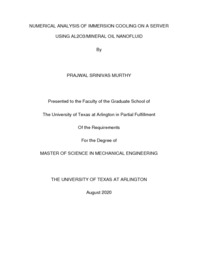| dc.description.abstract | In the current world, technology has developed significantly, with a massive processing and storage of data, resulting in the high increase in Power Density and Heat Generation of servers, computers and its components in data centers. This calls for an engineering solution, for efficient heat dissipation of these servers to ensure their reliability and prolonged working. Air cooling is a prominent method of data center cooling. However, due to its low heat carrying capacity, it is not an efficient method for cooling high heat generating servers. There are two methods to remove this heat, increasing the area of heat transfer being one of the methods, which is not feasible everywhere. To tackle this problem, liquid immersion cooling method has emerged as a prominent method for cooling servers and its components in data centers, where the servers can directly be immersed inside the liquid, making the process simpler and cost effective. Water has higher thermal properties like heat capacity, but the limitation is that the liquid must be dielectric to save equipment from short-circuit. This feature also influences the thermal conductivity of the liquids. Generally dielectric liquids have low thermal conductivity which affects the thermal performance of the cooling process. Thermal conductivity of the dielectric liquids is drastically increased with the introduction of nano particles, which has proven to be the best method.
Nano particles are metal and non-metal particles with the size between 1 to 150 nano-meters. To keep the dielectric feature of the liquid, the non-metallic nano particle can be added to the liquid. Therefore, the Alumina which is one of the materials using as an electrical insulation is used. The mean size of the nano particle used in this work is 80 nm and the liquid are mineral oil, which is a low-price liquid for immersion cooling compared to other dielectric liquids. The concentration of nano particles was 0 to 5 percent and it is assumed to remain homogeneous. The properties of the mixture were calculated based on the theoretical formula and it was function of temperature. In this work, we simulated heat transfer and effect of the nano particle concentration on the junction temperature of the processors using CFD techniques. The chosen server is an open compute server which has two processor in a row. The server was modeled in Ansys Icepack and simulations were performed for pure mineral oil and nano-fluid at particle concentrations of 1%, 3% and 5 % at 1, 2 and 3 LPM respectively. Prior to the study, effect of frame height on the maximum CPU junction temperature was tested using pure mineral oil. Drastic reduction in maximum CPU temperature was observed with a smaller frame height and this height was maintained throughout the study. Simulations were conducted for 3 different heatsink geometries, namely parallel plate, cylindrical bonded pin and plate fin heatsink. From results obtained, effect of nano-particle concentration on the maximum CPU junction temperature, pressure drop and pumping power were studied and comparisons were made for different nano-particle concentration and flow rates. Also, comparisons on CPU junction temperature, pressure drop, and pumping power obtained from simulations using the 3 different heatsink geometries were made. | |


